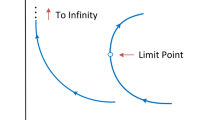Abstract
Several formulations are possible for the optimization of N-impulse two-body orbit transfers. One formulation that assumes the first N − 1 impulses are design variables, and implements Lambert’s algorithm in the final leg is considered here. This paper presents a derivation for the analytic expressions of the gradients needed to optimize a transfer using this formulation. The derivations of the analytic gradients, verification tests using complex-step differentiation, as well as numerical case studies for three-impulse orbit transfers are presented. The numerical case studies highlight a significant reduction in the computational cost, measured in terms of the number of objective function evaluations.







Similar content being viewed by others
Abbreviations
- ∥Δ v∥:
-
sum of magnitudes of instantaneous velocity changes (cost function), DU/TU
- r :
-
position vector, DU
- v :
-
velocity vector, DU/TU
- Δ t :
-
time of flight, TU
- t :
-
time on orbit, TU
- 𝜃 :
-
true anomaly, rad
- Δ 𝜃 :
-
difference between two true anomalies, rad
- E :
-
eccentric anomaly, rad
- H :
-
hyperbolic eccentric anomaly, rad
- n :
-
mean motion, rad/s
- e :
-
eccentricity
- p :
-
orbit parameter, DU
- μ :
-
gravitational parameter, DU3/TU2
- h :
-
specific angular momentum, DU2/TU
- a :
-
semi-major axis, DU
- \(\hat {p}, \hat {q} , \hat {w}\) :
-
perifocal frame
- \(f, g, \bar {f}\) :
-
Lagrange Coefficients
- t p→i :
-
time from perigee until point i, TU
- c :
-
cord, DU
- s :
-
half of the perimeter, DU
- x :
-
dummy variable
- α,β :
-
Lagrange Parameters
- N :
-
total number of impulses
- H :
-
hyperbolic orbit
- i,f :
-
initial and final orbits
- 1,2,3:
-
point on orbit
- −:
-
before impulse
- +:
-
after impulse
References
Abdelkhalik, O., Mortari, D.: N-impulse orbit transfer using genetic algorithms. J. Spacecr. Rocket. 44(2), 456–460 (2007). https://doi.org/10.2514/1.24701
Arora, N., Russell, R.P.: A fast and robust multiple revolution lambert algorithm using a cosine transformation. In: AAS/AIAA Astrodynamics Specialist Conference, AAS 13-728 (2013)
Arora, N., Russell, R.P., Strange, N., Ottesen, D.: Partial derivatives of the solution to the lambert boundary value problem. J. Guid. Contr. Dyn. 38(9), 1563–1572 (2015). https://doi.org/10.2514/1.G001030
Battin, R.H.: An introduction to the mathematics and methods of astrodynamics, rev. edn. American Institute of Aeronautics and Astronautics (1999). https://doi.org/10.2514/4.861543
Colasurdo, G., Pastrone, D.: Indirect optimization method for impulsive transfers. In: Astrodynamics Conference, AIAA 1994-3762 (1994). https://doi.org/10.2514/6.1994-3762
Conway, B.: Spacecraft trajectory optimization. Cambridge University Press (2009). https://doi.org/10.1017/cbo9780511778025
Ellison, D.H., Conway, B.A., Englander, J.A., Ozimek, M.T.: Analytic gradient computation for bounded-impulse trajectory models using two-sided shooting. J. Guid. Contr. Dyn. 41(7), 1449–1462 (2018). https://doi.org/10.2514/1.g003077
Ellithy, A., Abdelkhalik, O., Englander, J.: Impact of analytic derivatives on optimization of n-impulse orbit transfers. In: AAS/AIAA Astrodynamics Specialist Conference, AAS 20-491 (2020)
Gong, M., Zhou, D., Shao, C., Fang, Y.: Optimal multiple-impulse time-fixed rendezvous using evolutionary algorithms. J. Spacecr. Rocket., 1–7 (2021). https://doi.org/10.2514/1.a34946
Herman, A.L., Conway, B.A.: Direct optimization using collocation based on high-order gauss-lobatto quadrature rules. J. Guid. Contr. Dyn. 19(3), 592–599 (1996). https://doi.org/10.2514/3.21662
Lantoine, G., Russell, R.P., Dargent, T.: Using multicomplex variables for automatic computation of high-order derivatives. ACM Trans. Math. Softw. 38(3), 1–21 (2012). https://doi.org/10.1145/2168773.2168774
Lawden, D.F.: Optimal trajectories for space navigation, vol. 3. Butterworths (1963)
Luo, Y. Z., Zhang, J., Li, H.Y., Tang, G.J.: Interactive optimization approach for optimal impulsive rendezvous using primer vector and evolutionary algorithms. Acta Astronaut. 67(3-4), 396–405 (2010). https://doi.org/10.1016/j.actaastro.2010.02.014
Martins, J., Kroo, I., Alonso, J.: An automated method for sensitivity analysis using complex variables. In: 38th Aerospace Sciences Meeting and Exhibit, AIAA 2000-689 (2000). https://doi.org/10.2514/6.2000-689
Martins, J., Sturdza, P., Alonso, J.: The complex-step derivative approximation. ACM Trans. Math. Softw. 29(3), 245–262 (2003)
Pellegrini, E., Russell, R.P.: On the computation and accuracy of trajectory state transition matrices. J. Guid. Contr. Dyn. 39(11), 2485–2499 (2016). https://doi.org/10.2514/1.g001920
Pontani, M., Ghosh, P., Conway, B.A.: Particle swarm optimization of multiple-burn rendezvous trajectories. J. Guid. Contr. Dyn. 35(4), 1192–1207 (2012). https://doi.org/10.2514/1.55592
Prussing, J.: A class of optimal two-impulse rendezvous using multiple-revolution Lambert solutions. J. Astronaut. Sci. 48(2-3), 131–148 (2000). https://doi.org/10.1007/bf03546273
Prussing, J., Chiu, J.H.: Optimal multiple-impulse time-fixed rendezvous between circular orbits. In: Astrodynamics Conference, AIAA 1984-2036 (1984). https://doi.org/10.2514/6.1984-2036
Shen, H.X., Casalino, L., Luo, Y.Z.: Global search capabilities of indirect methods for impulsive transfers. J. Astronaut. Sci. 62(3), 212–232 (2015). https://doi.org/10.1007/s40295-015-0073-x
Shirazi, A., Ceberio, J., Lozano, J.A.: Spacecraft trajectory optimization: A review of models, objectives, approaches and solutions. Prog. Aerospace Sci. 102, 76–98 (2018). https://doi.org/10.1016/j.paerosci.2018.07.007
Vallado, D.A.: Fundamentals of Astrodynamics and Applications, 3rd edn. Space Technology Libary. Microcosm Press and Springer (2007)
Zhang, G., Zhou, D., Mortari, D., Akella, M.R.: Covariance analysis of Lambert’s problem via Lagrange’s transfer-time formulation. Aerosp. Sci. Technol. 77, 765–773 (2018)
Zhu, Y., Wang, H., Zhang, J.: Spacecraft multiple-impulse trajectory optimization using differential evolution algorithm with combined mutation strategies and boundary-handling schemes. Math. Probl. Eng. 2015, 1–13 (2015). https://doi.org/10.1155/2015/949480
Acknowledgements
Authors would like to thank Dr. Noble Hatten for his feedback and suggestions
Funding
This paper is based upon work supported by NASA, Award Number 80NSSC19K1642
Author information
Authors and Affiliations
Corresponding author
Ethics declarations
Conflict of Interests
The authors declare that they have no conflict of interest.
Additional information
Publisher’s Note
Springer Nature remains neutral with regard to jurisdictional claims in published maps and institutional affiliations.
This paper is based on a conference paper AAS 20-491 presented at the the AAS/AIAA Astrodynamics Specialist Conference, August 2020 [8].
Rights and permissions
About this article
Cite this article
Ellithy, A., Abdelkhalik, O. & Englander, J. Impact of Using Analytic Derivatives In Optimization For N-Impulse Orbit Transfer Problems. J Astronaut Sci 69, 218–250 (2022). https://doi.org/10.1007/s40295-022-00318-y
Accepted:
Published:
Issue Date:
DOI: https://doi.org/10.1007/s40295-022-00318-y




